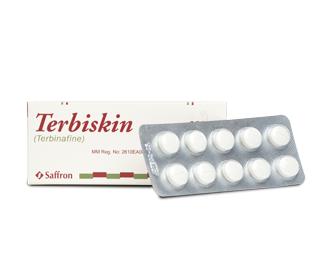
TERBISKIN 250mg Tablet
Therapeutic Class
Antifungal Agent (Oral)
Indications
Onychomycosis (fungal infection of the nail) caused by dermatophyte fungi. Tinea capitis Fungal infections of the skin for the treatment of tinea corporis, tinea cruis, tinea pedis and yeast infections of the skin caused by the genus candida (e.g Candida albicans) where oral therapy is generally considered appropriate owing to the site, severity or extent of the infection.
Chemical Composition
Each tablet contains Terbinafine hydrochloride 250mg
Packaging
1 x 10's per box
Dosage & Administration
No data is available in children under two years of age (usually <12 kg). Children above 2 years of age follow the following schedule: Children weighing <20 kg - 62.5 mg (half.125mg tablet) once daily. Children weighing 20 to 40 kg - 125 mg (one 125mg tablet or half 250mg tablet) once daily. Children weighing >40kg - 250 mg (two 125mg tablets or one 250mg tablet) once daily. Elderly: 250mg once daily. There is no evidence to suggest that elderly patients require different dosages or experience different side effects than younger patients. When prescribing tablets for patients in this age group, the possibility of pre-existing impairment of liver or kidney function should be considered. Skin infections: Recommended duration of treatment: • Tinea pedis (interdigital, planter/moccasin type) 2 to 6 weeks. • Tinea corporis, cruis: 2 to 4 weeks. • Cutaneous candidiasis: 2 to 4 weeks. Complete resolution of the signs and symptoms of infection may not occur until several weeks after mycological cure Hair and scalp infection: Recommended duration of treatment: • Tinea capitis: 4 weeks. • Tinea capitis occurs primarily in children. Onychomycosis: For most patients the duration of successful treatment is 6-12 weeks. Finger Nail Onychomycosis: Twelve weeks of therapy is sufficient for toe-nail infections in most cases. Some patients with poor nail outgrowth may require longer treatment. The optimal clinical effect is seen some months after mycological cure and cessation of treatment. This is related to the period required for outgrowth of healthy nail.
Contraindications
Hypersensitivity to Terbinafine or any of the excipients.
Side Effects
Frequency estimate: Very common > 10%, common > 1% to < 10%, uncommon > 0.1% to < 1%, rare > 0.01% to < 0.1%, very rare < 0.01%. In general Terbiskin tablets are well tolerated. Side effects are usually mild to moderate and transient. The most common are gastrointestinal symptoms (feeling of fullness, loss of appetite,dyspepsia, nausea, mild abdominal pain, diarrhoea), non-serious forms of skin reactions (rash,urticaria), musculoskeletal reactions (arthralgia, myalgia). Uncommon: Taste disturbances, including taste loss, which usually recover within several weeks after discontinuation of the drug. Isolated cases of prolonged taste disturbances have been reported. A decrease of food intake leading to significant weight loss was observed in very few severe cases. Rare: Hepatobiliary dysfunction (primarily cholestatic in nature) has been reported in association with. Terbiskin treatment, including very rare cases of serious liver failure.

